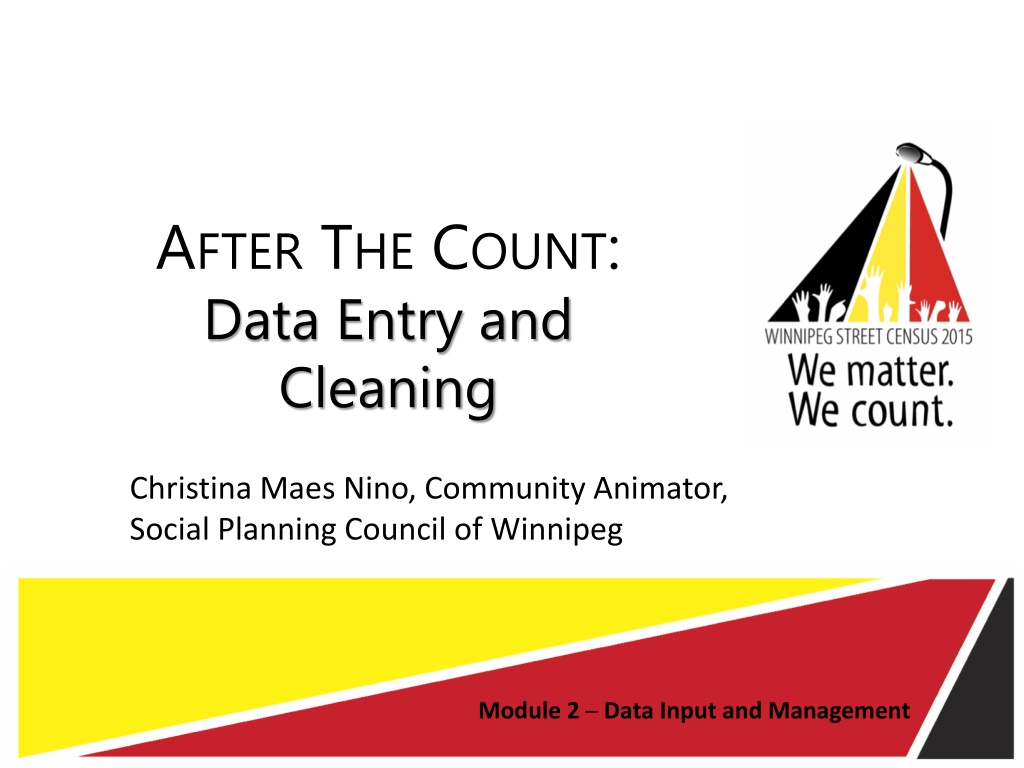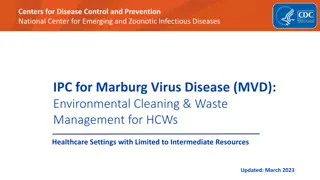Tips for Efficient Data Entry and Cleaning
Learn essential strategies for data entry and cleaning from the experience of the Winnipeg Street Census 2015. Get insights on post-count activities, organizing survey data, identifying errors, and reducing duplicates to enhance the validity and reliability of your analysis.
Download Presentation

Please find below an Image/Link to download the presentation.
The content on the website is provided AS IS for your information and personal use only. It may not be sold, licensed, or shared on other websites without obtaining consent from the author.If you encounter any issues during the download, it is possible that the publisher has removed the file from their server.
You are allowed to download the files provided on this website for personal or commercial use, subject to the condition that they are used lawfully. All files are the property of their respective owners.
The content on the website is provided AS IS for your information and personal use only. It may not be sold, licensed, or shared on other websites without obtaining consent from the author.
E N D
Presentation Transcript
AFTER THE COUNT: Data Entry and Cleaning Christina Maes Nino, Community Animator, Social Planning Council of Winnipeg Module 2 Data Input and Management
Post Count Activities THE WINNIPEG STREET CENSUS2015
Post Count Activities These are actually PRE Count: Write EVERYTHING down, ideally in the same place Have a plan and a deadline for data entry and analysis DURING the count: Keep the surveys organized at the base sites Keep track of all the shelter data locations and send reminders to people who will fill them in Keep track of everyone who may have surveys in other locations and send reminders to collect them THE WINNIPEG STREET CENSUS2015
Post Count Activities We: Kept surveys in envelopes organized by volunteer Went through each volunteer survey, looked for obvious issues Made a plan to deal with surprise survey issues THE WINNIPEG STREET CENSUS2015
Entering Data We: Tested data entry in advance Held a training session with all data entry volunteers Marked everything data entry volunteers changed, added, or data that stood out as a likely error Only had 4 volunteers with attention to detail and a lot of time for data entry THE WINNIPEG STREET CENSUS2015
Entering Data Other tips for data entry? THE WINNIPEG STREET CENSUS2015
Objectives of Data Cleaning Eliminate (or reduce) duplicates Eliminate (or reduce) errors in data entry and data collection Increase validity/ reliability of analysis Any others? THE WINNIPEG STREET CENSUS2015
Reducing Duplicates Use identifying information to check for duplicates For Winnipeg Street Census DOB/Aboriginal Status/Gender THE WINNIPEG STREET CENSUS2015
Reviewing Possible Errors Conduct frequency analysis for EVERY variable in your dataset Logic Checks are responses logical? Was the age of the respondent 120 years old? Did a person self- describe as male also report being pregnant? Review: Mean, median, mode, standard deviation, skewness, kurtosis, range (MINIMUM AND MAXIMUM VALUES) THE WINNIPEG STREET CENSUS2015
Reviewing Possible Errors By requesting a graphic (bar chart/scatterplots/ histogram) for each variable you can catch problems visually Real outliers vs. coding errors This will allow you to identify coding errors by variable and begin to correct them THE WINNIPEG STREET CENSUS2015
Increase Validity/Reliability of Analysis: Code Other Responses Example: Q: What is the reason you first became homeless? A: Mom died; children passed away; parents death; 1. Read through all the responses to see if they belong to an existing category 2. Create new categories if a certain answer is repeated often 1. New category for death in family 2. If the Other category large, (12-20%) then consider developing new categories otherwise bivariate analysis might lose meaning THE WINNIPEG STREET CENSUS2015
Increase Validity/Reliability of Analysis: Deal with Missing Responses If it doesn t make logical sense, doesn t seem valid, mark it as missing Check that all the symbolic data (eg. 01 where the month was missing) is entered consistently Note fields where there is a lot of missing data so it is not used in analysis incorrectly THE WINNIPEG STREET CENSUS2015
Increase Validity/Reliability of Analysis: Deal with Missing Responses Key questions to check: How old were you when you first became homeless? When did you become homeless most recently? How many times have you been homeless in the past three years? How long have you been homeless throughout your lifetime? THE WINNIPEG STREET CENSUS2015
Reviewing Possible Errors, Checking Reliability/Validity Other ways to check for errors? THE WINNIPEG STREET CENSUS2015
Things Ive found helpful: - If you don t know, ask - Use resources in the community (academics, health authority staff) as well as people from other communities - Be realistic about the limitations of your data























